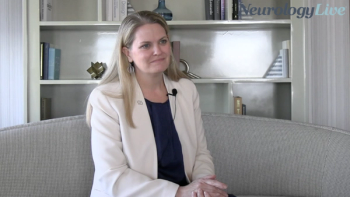
Processing Speed Test Feasible and Meaningful in Multiple Sclerosis Care
The Processing Speed Test, a tech-enabled version of the SDMT, was shown to be significantly correlated with multiple measures in routine multiple sclerosis care.
Gabrielle Macaron, MD
Results from cross-sectional clinical data on the Processing Speed Test (PST)—a technology enable version of the Symbol Digit Modalities Test (SDMT)—suggest the application is a meaningful measure for routine multiple sclerosis (MS) care after showing correlation with patient-reported outcome measures (PROMs), magnetic resonance imaging (MRI) measures of focal, and diffuse brain injury and employment.
Using linear regression, the investigators noted that self-reported physical disability, cognitive function, fatigue, and social domains were among the strongest predictors of PST scores (adjusted R2 = 0.44; P <.001). Additional variables such as T2 lesion volume, whole brain fraction, and cord atrophy were among the strongest clinical MRI variable predictors of PST scores (adjusted R2 = 0.42; P <.001).
“The integration of technology-enabled data capture into routine care allowed efficient assessment of a representative real-world cohort. These results support the relevance of PST as an outcome measure in clinical practice and trials and as a potential clinical marker of neurodegeneration in MS,” lead investigator Gabrielle Macaron, MD, neurologist, Mellen Center for Multiple Sclerosis, Cleveland Clinic, and colleagues, concluded.
The cross-sectional study included 997 patients with MS seen at a tertiary center between September 2015 and December 2017 undergoing PST and PROM assessments, as well as brain MRI within 90 days. Patients underwent more specified tests such as the Multiple Sclerosis Performance Test (MSPT) for processing speed and the Patient Determined Disease Steps (PDDS), which correlated with scores from the Expanded Disability Status Scale (EDSS) to determine physical disability.
Other patient-reported outcome measures included the Patient Health Questionnaire (PHQ9), which evaluated depression and the Quality of Life in Neurological Disorders questionnaire (Neuro-QOL), which measured quality of life. MRIs were analyzed using semi-automated methods and correlations of PST with PROMs and MRI metrics were examined using Spearman’s rho. MRI metrics and PST quartiles were compared using Wilcoxon Rank Sum Testing while linear regression models identified predictors of PST performance.
READ MORE:
After excluding patients who did not either complete the PST or had missing Neuro-QOL scores, the final analysis included 721 patients (mean age, 47.6 +11.4 years).
Researchers found significant correlations between PROM scores and PST scores, as well as moderate correlations with self-reported physical disability (lower extremity function: R2 = 0.48 [95% CI, 0.42—0.53; P <.001]; upper extremity function: R2 = 0.43 [95% CI, 0.37—0.49]; P <.001]), self-reported cognitive function (R2 = 0.30 [95% CI, 0.23—0.36]; P <.001), social participation (R2 = 0.37 [95% CI, 0.31—0.44]; P <.001]and social satisfaction (R2 = 0.33 [95% CI, 0.27—0.40]; P <.001], as measured by the Neuro-QOL.
As for correlations between PST scores and MRI metrics, data showed a significant correlation between PST and MRI-assessed disease severity (P <.001) as well as cord atrophy (P <.001) and deep grey matter volumes (P <.001).
There was a statistically significant correlation between objective and subjective cognitive function and the effect of depression (P = .001). Patients who were more depressed reported worse cognition that did not necessarily reflect their PST performance.
A statistically significant difference in PST scores was identified among different employment categories, with worse performance in patients who were retired (mean score, 38.2 ±9.8), disabled (mean score, 40.1 ±11.1), or unemployed (mean score, 44.0 ±11.6) compared to those working full-time (mean score, 53.5 ±11.1), part-time (mean score, 51.5 ±12.0), students (mean score, 60.5 ±14.3), and homemakers (mean score, 47.8 ±16.2).
“Our study provides standardized, comprehensive, and large-scale real-word data from clinical practice on the relation of cognitive processing speed with other measures of MS disease status. PST scores correlated with multiple PROMs, numerous MRI metrics, and employment status. To our knowledge, this is one of the largest studies describing the correlation of standardized cognitive testing with PROMs, MRI metrics, and employment,” Macaron and colleagues concluded.
REFERENCE
Macaron G, Baldassari LE, Nakamura K, et al. Cognitive processing speed in multiple sclerosis clinical practice: association with patient-reported outcomes, employment, and MRI metrics.
Eur J Neurol. Published online March 28, 2020. doi: 10.1111/ene.14239
Newsletter
Keep your finger on the pulse of neurology—subscribe to NeurologyLive for expert interviews, new data, and breakthrough treatment updates.


































